Review: LACO Highlights Chamber Music by Women Composers
The prolific German composer Fanny Mendelssohn-Hensel (1805-1847) wrote some 450 works - "but many were published under her brother's name," said Los Angeles Chamber Orchestra (LACO) concertmaster Margaret Batjer.
That anecdote brought an audible gasp from the full audience gathered at The Huntington's Rothenberg Hall in San Marino, Calif. for an evening of chamber music by women, played by members of LACO.
The program, curated by Batjer, featured works by Fanny as well as her contemporaries Clara Schumann (1819-1896) and Louise Farrenc (1804-1875), and from this century, Sarah Gibson (1986–2024) and Nokuthula (Thula) Ngwenyama (b. 1976).
While all five composers faced personal and societal challenges, some because of gender and some not, their works stand on their own merits, Batjer said. "These are five unique and individual composers who just happened to be women."
Clara Schumann, whose "Three Romances, Op. 22" opened the evening, "had the unwavering support of her husband" in a time when few women did, Batjer said. She noted that Robert Schumann even expressed regret that his wife didn't have more time for composition, as busy as she was with her career as a pianist and with the couple's eight children.
The "Three Romances" were among Clara's final compositions. They were composed near the end of Robert's life - Clara was to live for 40 years after his death, but stopped composing, in her grief. They were premiered in 1854 by the great violinist Joseph Joachim, with Clara at the piano.
These pieces have increased in popularity in recent years - in 2021 Barenreiter came out with an excellent new urtext (sheet music) edition of the Three Romances, and these days they appear with more frequency on recital programs and in student master classes.
On Sunday they were performed by violinist Tereza Stanislav and pianist Kevin Fitz-Gerald, who gave the three pieces an elegant reading - bringing out more of the music's beauty than its edgy emotions.
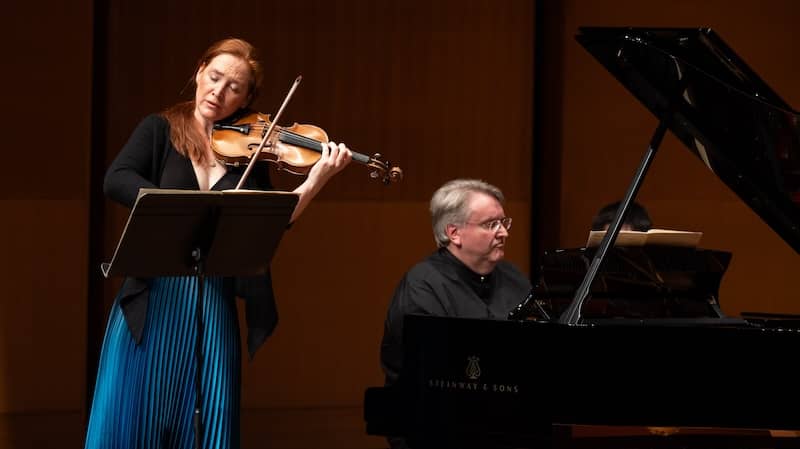
Violinist Tereza Stanislav and pianist Kevin Fitz-Gerald. Photo by Brian Feinzimer.
Having first shaped my perspective on these works by reading through that Barenreiter score, it was interesting to take in this music as an audience member. I found myself musing about the meaning of this music as "Romance" - in the context of the Schumanns' 26-year relationship and 14-year marriage. I heard a progression: the first Romance feels exploratory, like the beginning of something, peppered with hesitation and meandering ideas. The second movement contrasts dark and light, in turns serious and playful. It ends with a little pizzicato, which Stanislav and Fitz-Gerald delivered with such delightful precision that the audience gave an audible "Mmmmmm" of satisfaction.
The third Romance feels like a triumph - tidy and sure, relieved of most conflict. "Kids, this is the story of Mom and Dad's smooth and inevitable relationship, which was never in doubt." It's the story you tell at the end, without the rocky details (the illicit engagement, Grandpa vigorously opposing the marriage, etc.)
The second piece on the program, "I do not want horses or diamonds," was inspired by Clara Schumann, the title coming from one of Clara's letters to Robert, expressing her desire for a simple life with him. It was written by Sarah Gibson, a dedicated composer and teacher who died of cancer less than a year ago at the age of 38, leaving behind a newborn and her husband Aaron Fullerton. Among her many accomplishments was her post as a teaching artist for the LA Phil's Composer Fellowship Program and teaching at USC and the Colburn School.
Fullerton was present at the concert, and he came to the stage to name the recipient of the first commission from the Sarah Gibson Foundation: the composer and violist Julia Moss, who was also in the audience.
Gibson's piece for this concert was commissioned by LACO and composed in 2020, in consultation with Batjer. "She dedicated this piece to LACO and to me," Batjer said, "and I dedicate this performance to her."
Batjer played the piece with violinist Jason Issokson, cellist Kevin Fitz-Gerald, violist Jonathan Moerschel and cellist Trevor Handy.
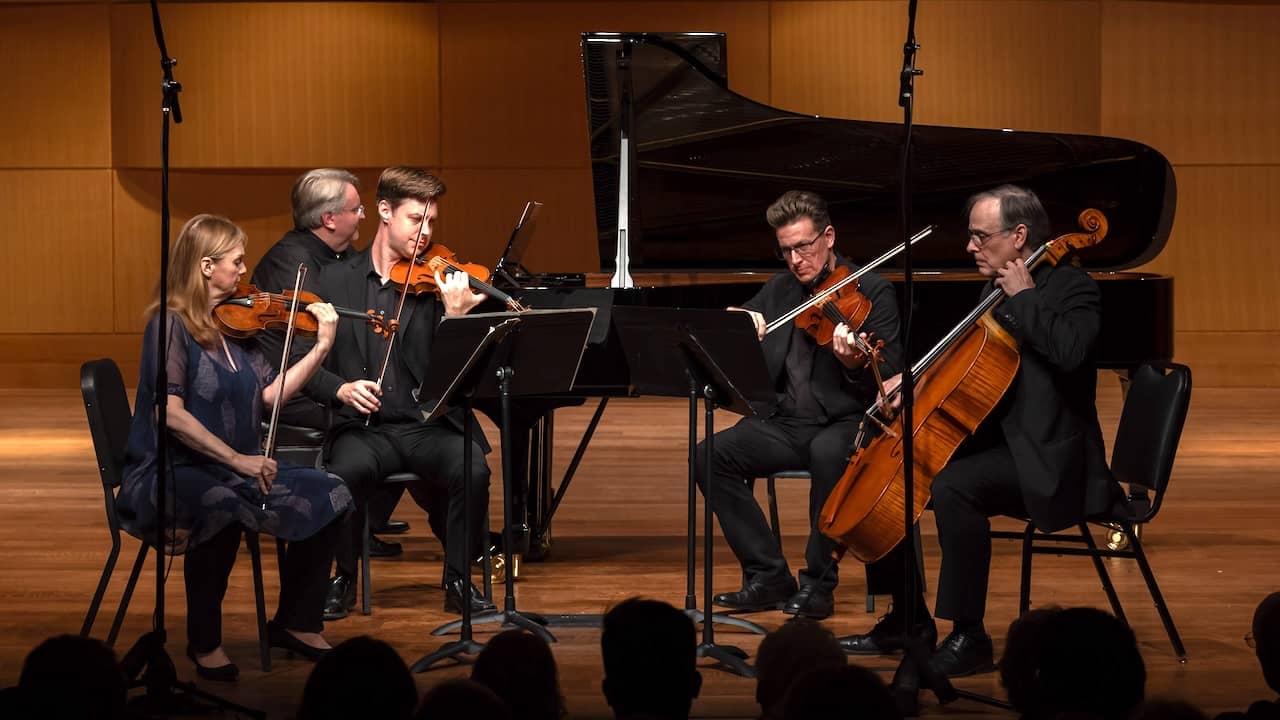
Violinist Margaret Batjer, pianist Kevin Fitz-Gerald, violinist Jason Issokson, violist Jonathan Moerschel and cellist Trevor Handy. Photo by Brian Feinzimer.
Gibson's piece was original and inventive, relishing in special effects without being pointlessly novel. It began with a simple, very high note in the first violin, cushioned in silence. After a few notes like this the second violin began to echo the first, sliding downwards in short glissandos. The pianist went inside the piano for a plink, then back to the keys for some atmospheric high notes, now undergirded by sustained notes in the viola and cello.
The overall effect was sparkly, alternating between consonance and dissonance, with motion, gesture and contrast - very engaging. The ending was a tiny masterpiece: the strings played with such slow bows as to sound nearly inaudible, garnished at the very end with the soft metallic strum inside the piano of its highest strings.
Following this was Nokuthula (Thula) Ngwenyama's "Down," played by flutist Sandy Hughes, violist Robert Brophy and harpist Anya Garipoli. Its title implies downward motion, and also being "down" with something, in Thula's case, a solidarity with Ukraine, as she quotes Julia Gomelskaya's Symphony No. 2 "Ukraine Forever." There were trills, flutter-tongues, tremolos and glissandi utilized to explore this combination of instruments: the low voice of the viola, the strum of the harp, the piercing high voice of the flute. Interestingly, "Down" ended in an ascent!
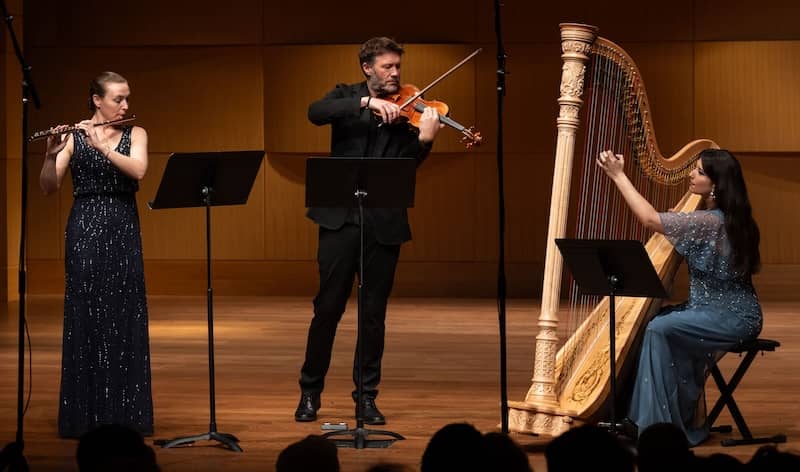
Flutist Sandy Hughes, violist Robert Brophy and harpist Anya Garipoli. Photo by Brian Feinzimer.
For me the big "find" of the evening was Fanny Mendelssohn-Hensel's String Quartet in E flat major - a well-crafted piece played with engaging vigor by violinists Jason Issokson and Carrie Kennedy, violist Jonathan Moerschel and cellist Trevor Handy.
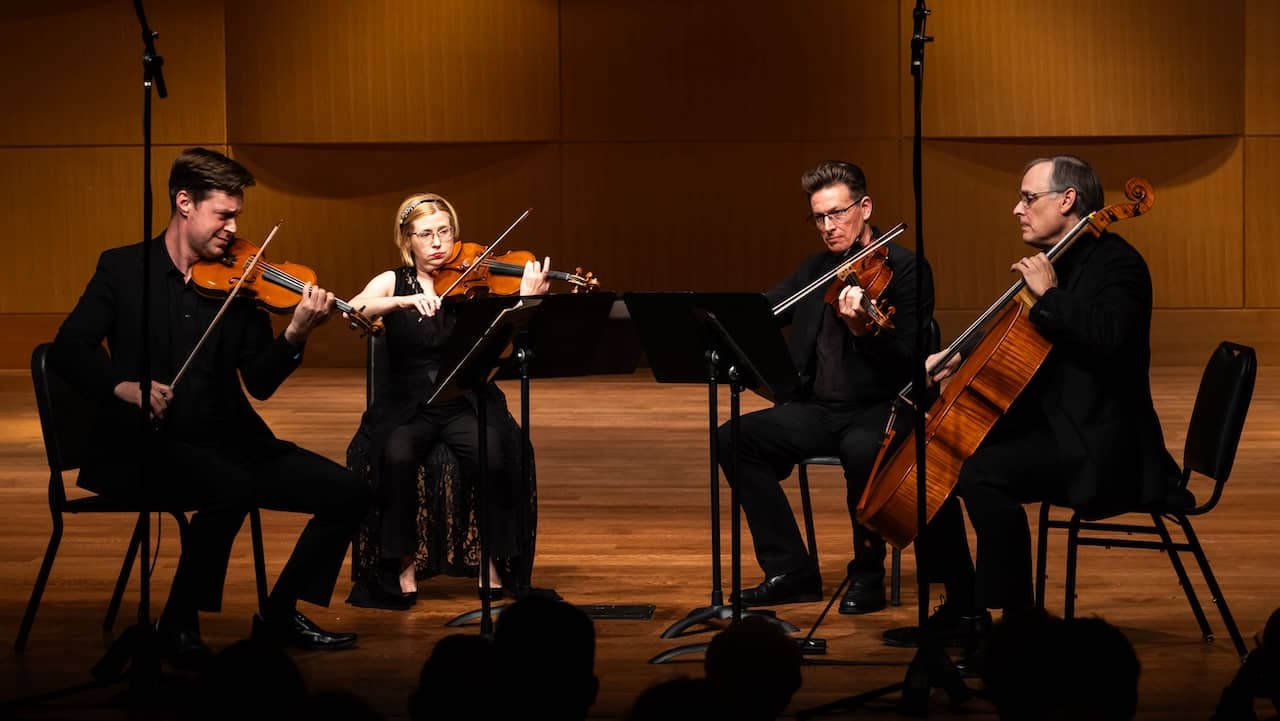
Violinists Jason Issokson and Carrie Kennedy, violist Jonathan Moerschel and cellist Trevor Handy. Photo by Brian Feinzimer.
The first movement began slowly, with a slightly dark atmosphere, and this foursome played with drama and strategic silences. In the second movement they brought out the interaction inherent in Fanny's writing with exciting motion. They kept tempos right on the brink, lending to the excitement and commanding attitude, that feeling that they were "going for it" and also nailing it. The slow third movement brought some lovely cello playing from Handy, and the fourth movement was full of intricate interplay at high velocity (what a gnarly second violin part)! The unison playing among this group was remarkable, as was its control of dynamics.
In life, Fanny's biggest challenge was her father's outright refusal to allow her to pursue music as a profession, while her brother Felix Mendelssohn enjoyed great success and recognition. If only she could have witnessed this reading of her quartet! What an exciting performance.
The second half of the program was fully devoted to French composer Louise Ferrenc's "Nonet," billed as the central piece in this concert. Per the name, it was performed by nine musicians: four strings and five winds.
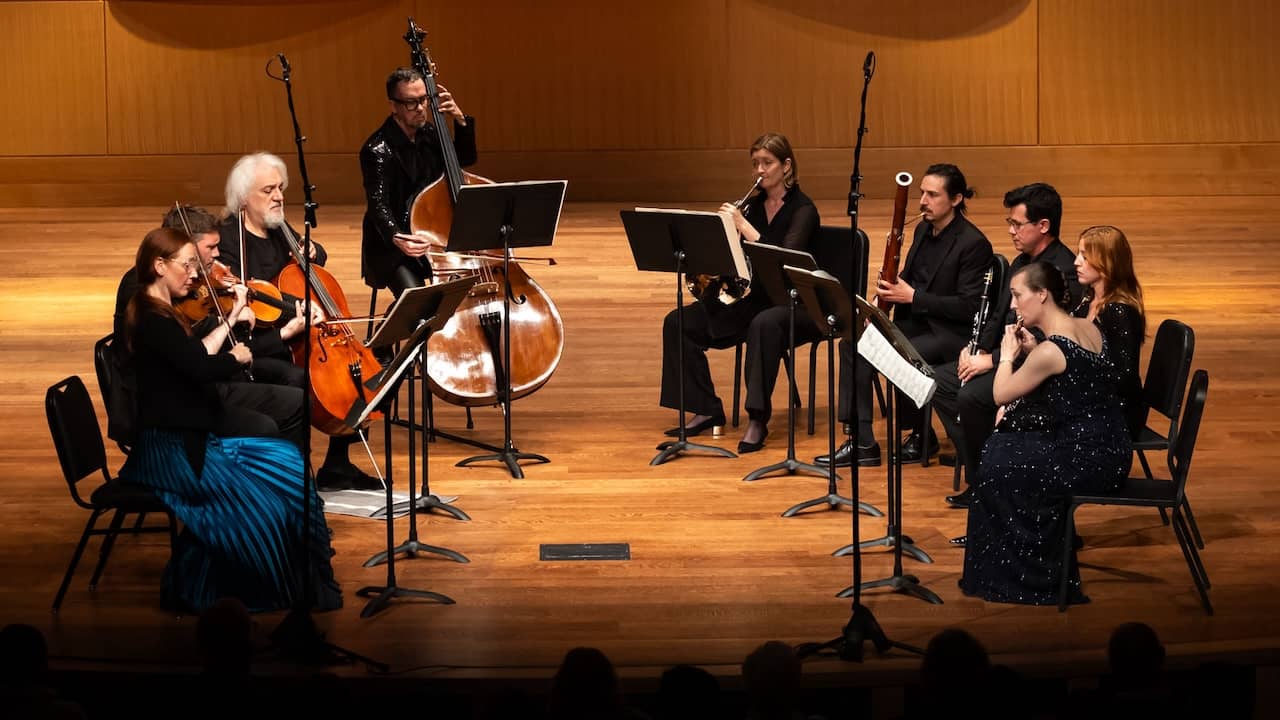
Nonette: an orchestra of nine. Photo by Brian Feinzimer.
In the mid 19th century Ferrenc was Professor of Piano at the Paris Conservatoire - the only woman to hold such a position at the time, and her compositions were published and even popular during her lifetime.
The "Nonet" was one of her most popular works, and in it she achieves a robust, nearly orchestral sound with the combination of violin, viola, cello, bass, French horn, bassoon, clarinet, oboe and flute. The first movement begins with stateliness of a Mozartian opera overture, the second movement "Andante con moto" is one of those pleasant walks (with variations); I thought of the gardens right outside the hall, at the Huntington. There is much opportunity for various instrument combinations to interact, notably in the third movement, between viola and winds.
Overall - there's probably a reason why the "nonet" as a genre never quite caught on like, say, the quartet: it's too small for a conductor, but too big for easy communication. Even with musicians as superb as in this group, the rhythmic cohesion occasionally faltered. Still, it was a top-notch reading of an unusual work that is worth the renewed attention.
You might also like:
- Review: Los Angeles Chamber Orchestra Honors Stradivari Violins with Strad Fest LA
- REVIEW: Violinist Nemanja Radulovic's U.S. debut with the Los Angeles Chamber Orchestra
* * *
Enjoying Violinist.com? Click here to sign up for our free, bi-weekly email newsletter. And if you've already signed up, please invite your friends! Thank you.
Replies
Hi Sheila, thank you so much for writing and sharing your unique connection and perspective about these historical individuals, about whom so much has been written and speculated. It sounds like Fanny certainly had to contend with serious familial control being exercised over her musical accomplishments and aspirations.
Where can people see your documentary? I'd love to see it and I'm sure many of us would. Please give us more information about it and any related links!
It's good to see Fanny Mendelssohn and Clara Schumann getting the attention and respect that is so long overdue.
This article has been archived and is no longer accepting comments.
Violinist.com is made possible by...
Dimitri Musafia, Master Maker of Violin and Viola Cases
International Violin Competition of Indianapolis
Violinist.com Holiday Gift Guide
Violinist.com Holiday Gift Guide
Johnson String Instrument/Carriage House Violins
Subscribe
Laurie's Books
Discover the best of Violinist.com in these collections of editor Laurie Niles' exclusive interviews.

Violinist.com Interviews Volume 1, with introduction by Hilary Hahn

Violinist.com Interviews Volume 2, with introduction by Rachel Barton Pine








April 10, 2025 at 01:27 PM · Hello, as Fanny Mendelssohn's 3x great granddaughter and the director of the recent documentary 'Fanny: The Other Mendelssohn', I need to correct a couple of things in this review. First, not 'many of her works' but only a few songs were published under her brother Felix's name. He disapproved of her composing in other genres than song, to the extent that he refused to programme the very string quartet reviewed here. So he would certainly not have published them. The 'Easter Sonata', featured in my film, was an unsigned manuscript passed off as Felix's to a buyer in 1972, but at the time known to be by Fanny.
Second, Robert Schumann did not give his wife Clara his 'wholehearted support'. He was very supportive of her earning the family's bread by performing on the piano so he could go on composing, but actively discouraged her attempts at composing, for which, in any case, her performing schedule left no time. Any expressions of regret were, as British diplomats might say, 'economical with the truth'.
I am always delighted when Fanny's masterpieces are programmed, but a bit of fact checking by reviewers wouldn't go amiss.
Thank you.